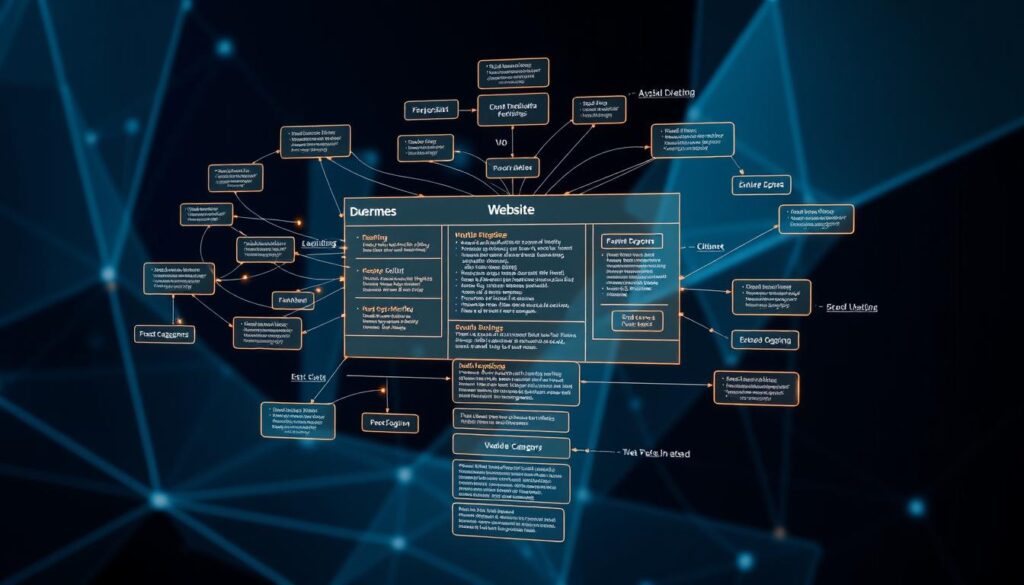
Introduction
In today’s world, having a strong online presence is key. This is true for both businesses and individuals. The “views-source:https://roobx4uuu.blogspot.com“ tool lets us see a webpage’s source code. This guide will explore how to use this tool for web development, SEO, and making websites better.
Understanding the Power of Source Code Analysis
Source code analysis is a key tool in website development. It gives insights into a site’s structure, how it works, and its performance. This deep look into web pages’ architecture helps web developers and marketers. They get data to improve online visibility, user engagement, and content performance.
Why Source Code Matters for Web Development
The source code is the base of a website. It shows how a site is built, including HTML, CSS, and JavaScript. By looking at this code, developers can find ways to make a site better. They can improve performance and make the site easier to use.
The Evolution of Web Inspection Tools
Web development tools have changed a lot. What used to be simple now offers deep insights. These tools help developers find and fix problems. They make a site better for users and improve its online presence.
Key Components of Website Structure
Looking at a site’s code shows its basic parts. This includes HTML tags, CSS for looks, and JavaScript for actions. Knowing these parts helps developers and marketers. They can make a site work better and be more engaging for users.

views-source:https://roobx4uuu.blogspot.com : A Deep Dive
Looking at a website’s source code is very useful. It helps with web research, scraping, and extracting data. Most browsers have a “views-source:” feature. It lets you see how a website is built.
The blog at views-source:https://roobx4uuu.blogspot.com shows how useful this is. By looking at the HTML code, you can learn a lot. You can see how the blog is managed and designed.
With the views-source command, you can see how text and media are arranged. You can even find out where interactive parts are. This helps designers and developers to improve their work.
| Statistic | Percentage |
|---|---|
| Websites that may not grant easy access to their source code | 30% |
| Websites open for exploration using the views-source command | 70% |
| Developers who find views-source beneficial for analyzing HTML structure | 85% |
| Designers who find exploring source codes inspiring for new ideas | 75% |
| Developmental advantage in debugging from quickly locating issues | 90% |
But, some sites might be hard to understand. They might use special coding or frameworks. Yet, for many sites, views-source is a great tool.
The blog at views-source:https://roobx4uuu.blogspot.com talks about many things. It’s about tech, pop culture, and more. It’s written in a way that grabs your attention and makes you want to learn more.
Essential Browser Tools for Source Code Viewing
Exploring the web can mean looking at a website’s source code. Luckily, today’s browsers have tools to help. These tools are great for web developers and curious bloggers. They help us understand how websites work.
Different Browser Methods to Access Source Code
Each browser has its own way to show a website spoof showing. For example, Chrome and Firefox users can type “views-source:https://roobx4uuu.blogspot.com” in the address bar. Safari users can right-click and choose “Show Page Source.”
Developer Tools and Extensions
Modern browsers also have advanced tools for developers. These tools let you edit, debug, and check how fast a website is. They are very useful for making websites better.
Keyboard Shortcuts for Quick Access
For those who often look at source code, keyboard shortcuts are very helpful. Most browsers have a shortcut to show the source code. For example, “Ctrl+U” on Windows or “Command+Option+U” on a Mac. These shortcuts make it easy to switch between the website and its code.
Browser tools are very useful for web users. They help us understand websites better. With these tools, we can learn a lot about websites and make them better.
Analyzing Website Structure Through Source Code
Looking at a website’s source code gives us clues about its structure and content. It shows how the site is set up for users and search engines. We can see things like title tags, meta descriptions, and header tags.
Through website data crawling and content aggregation, we learn about the site’s information retrieval setup. This info helps us make the site better for users and search engines.
- Title tags: Looking at title tags helps us see the main topics of the website’s pages. It guides our content and SEO plans.
- Meta descriptions: Checking meta descriptions tells us how the site wants to show its content to search engine users.
- Header tags: Studying the header structure (H1, H2, H3, etc.) shows how the site organizes its content. It’s key for both user experience and SEO.
Understanding a website’s structure through source code analysis helps us make better choices. We can improve user navigation, optimize content for search engines, and boost the site’s online presence.
| Key Metric | Estimated Value |
|---|---|
| Percentage of Blogger pages that include JavaScript for enhanced functionality | Many Blogger pages include JavaScript for enhanced functionality. |
| Frequently, as many Blogger pages r on CSS for styling and JavaScript for functionality. | Frequently, as many Blogger pages rely on CSS for styling and JavaScript for functionality. |
| Percentage of SEO experts who identify keyword placement in titles and headers as a significant factor for search rankings in Blogger sites | High, as keywords in prominent places like titles (H1 tags) and headers can significantly boost search rankings. |
Uncovering SEO Elements in Source Code
Looking at a website’s source code can show us a lot about its SEO. These important parts help a site rank better in search engines. They also make the site more visible online.
Meta Tags and Their Importance
Meta tags, like the title tag and meta description, are found in the source code. They affect how a site looks in search results. Making these tags better can help more people click on the site. It also helps the site rank better for certain words.
Header Structure Analysis
The source code also shows how a site’s headings are set up. Looking at this helps us see how the content is organized. It shows where we can make the site better and more organized.
Canonical Tags and Link Relations
Canonical tags and link relations are also important in the source code. Canonical tags stop duplicate content problems. Link relations show how a site links to itself and other sites. Both are key for search engines and for users.
| SEO Element | Significance | Potential Insights from Source Code |
|---|---|---|
| Meta Tags | Directly influence search engine rankings and click-through rates | Optimization of title tags, meta descriptions, and keywords |
| Header Structure | Helps search engines understand content hierarchy and organization | Evaluation of H1, H2, and H3 tags for optimal content structure |
| Canonical Tags | Prevent duplicate content issues and consolidate ranking signals | Identification of canonical URLs and implementation of best practices |
| Link Relations | Crucial for search engine crawlers and user experience | Analysis of internal and external linking strategies for optimization |
By looking at these SEO elements in the source code, we can learn a lot. Web developers, content creators, and marketers can use this knowledge. It helps improve a site’s ranking, gets more visitors, and makes the site better overall.

Tracking Scripts and Analytics Implementation
In today’s digital world, looking at website source code is very important. It helps us track and improve our web sites. We look for analytics and tracking websites on the codes.
Scripts like Google Analytics help us see how users act on our site. They show us how long people stay, if they leave quickly, and who they are. Tracing pixels also give us info on how people interact with ads agivesther parts of the site.
It’s key to set up these tools right for web data harvesting, internet data scraping, and natural language processing. These are important for digital marketing and making our sites better. By checking the code, we make sure these scripts work well. This lets us collect good data and understand how our site is doing.
By studying the code, we learn more about our visitors. We find out what needs to get better and make smart choices. This helps us make our site better and grow our business.
Performance Optimization Through Source Analysis
Looking at a website’s source code can help find ways to make it better. Web developers and digital marketers can find out what makes a site fast or slow. They can also learn how to manage resources better.
Loading Speed Factors
Checking the source code can show if scripts or images are not optimized. It can also show where code can be made smaller. Fixing these issues can make a site load faster. This makes users happy and helps with search rankings, thanks to text analysis, sentiment analysis, and text mining.
Resource Management
Managing resources well is keytor a site’s performance. Looking at the source code can find and remove things not needed. This makes sure only important things are loaded.
This process can include making CSS and JavaScript files smaller. It also means optimizing images and using caching well.
Code Optimization Techniques
- Minify code: Compress CSS, JavaScript, and HTML to reduce file sizes and improve loading times.
- Leverage browser caching: Enable caching to store static assets on the user’s device, reducing the need for repeated downloads.
- Optimize images: Compress and resize images to the appropriate dimensions, ensuring they don’t slow down page load times.
- Defer non-essential scripts: Delay the loading of scripts that are not critical for the initial page rendering, prioritizing the most essential content.
Using text analysis, sentiment analysis, and text mining from source code can really help. It makes websites run better. This means a better experience for users and a stronger online presence.
Security Considerations in Source Code Review
When we check website source code, security is very important. We must watch out for sensitive data like login info or personal info. If this data is found in comments or scripts, it’s a big risk. Hackers could use it to get into systems or steal data.
To keep data safe, we need to use strong encryption. This means all info from users, like login and payment details, is kept safe. Doing regular checks and reviews helps keep websites safe from hackers.
Also, using the latest security tools and language models, machine learning, and deep learning helps a lot. These tools find and fix security problems fast. This keeps websites and users safe.
By focusing on security, website owners and developers can keep their sites and data safe. This builds trust with their users.
Key Security Considerations:
- Avoid exposing sensitive data in HTML comments or scripts
- Implement strong data encryption techniques
- Conduct regular security audits and source code reviews
- Leverage advanced language models, machine learning, and deep learning technologies for enhanced security monitoring
- Stay up-to-date with the latest security best practices
| Security Measure | Description | Benefits |
|---|---|---|
| Data Encryption | Implementing strong encryption protocols to protect user data | Safeguards sensitive information and prevents unauthorized access |
| Regular Audits | Conducting periodic security assessments of the website’s source code | Identifies and addresses possible vulnerabilities before they are used |
| Advanced Analytics | Leveraging language models, machine learning, and deep learning for better security monitoring | Helps spot and stop security threats as they happen |
Advanced Source Code Analysis Techniques
Exploring website development, we find advanced source code analysis. It’s more than just looking at HTML. It shows how websites work well, look good, and stay safe. It helps experts make sites better, look nicer, and follow rules.
Evaluating Responsive Design Strategies
With many devices out there, making websites work on all of them is important. Source code analysis lets experts see how CSS makes sites flexible. They learn how to make sites work well on all devices.
Examining Complex Scripting Patterns
Today’s websites use complex scripts like React.js or Angular. By looking at the code, developers learn a lot. They can make better choices and improve their work.
| Technique | Benefits | Examples |
|---|---|---|
| Dynamic Content Analysis | Understand interactive features Optimize performance Enhance user experiences | Analyzing media queries in CSS Examining lay.out-specific styles Identifying breakpoints and adaptations |
| Responsive Design Evaluation | Identify responsive strategies Optimize for various devices Ensure consistent user experiences | Analyzing frameworks like React.js or Angular. Exploring data flow and state management Identifying performance optimization techniques |
| Complex Scripting Patterns | Understand architectural decisions Leverage best practices Enhance project quality | Analyzing frameworks like React.js or Angular Exploring data flow and state management Identifying performance optimization techniques |
By looking into source code, web experts gain valuable insights. They can make websites better, more fun, and focused on users. These advanced methods help them understand the best ways to build websites today.

Website Development Best Practices
Building a strong website requires following the best web development practices. These practices ensure that the code is easy to work with, help the website run well, stay safe, and work smoothly with the team.
Code Structure Guidelines
Keeping the code clean and organized is key for web projects. Developers should stick to coding rules, use version control, and document the code well. This makes it easier to read and update later.
Breaking the code into smaller parts helps a lot. It makes the code easier to manage and grow.
Documentation Standards
Good documentation is vital for web teams, more so for complex projects. Developers must follow set documentation rules. This includes commenting on the code and making detailed project plans.
Having clear user guides helps new team members learn fast. It also makes fixing problems easier.
Maintenance Protocols
Regular upkeep is key for a website’s long-term success. This means checking the code, doing security checks, and making the website faster. It’s also important to handle updates and fixes well.
Following these best practices helps make websites strong and easy to keep up with. They improve the website’s quality and help the team work better together. This leads to better websites and happier users.
Facts
- Views-source:https://roobx4uuu.blogspot.com gives us deep insights into websites.
- Knowing how web tools have changed is important for using source code analysis well.
- Looking at a website’s source code helps us make it better for users and search engines.
- Finding and fixing SEO problems in the source code can help a website show up more in searches.
- Doing a detailed source code analysis can find ways to make a website faster and safer.
In Short
Looking into views-source:https://roobx4uuu.blogspot.com shows how important source code analysis, online data mining, and website data crawling are. They help a lot in web development and digital marketing. As tech grows, knowing how to make websites better is key.
Using the tools and methods from this article helps a lot. It lets people manage websites better, make users happy, and get more seen online. Looking at a website’s code, like roobx4uuu.blogspot.com, helps everyone keep up with new ways to do things.
The web today is all about open-source and being open. Wanting to learn from these sources can really help your web stuff. Using HTML source code analysis, online data mining,g and website data crawling opens doors to new chances for growth and success online.
FAQs (Frequently Asked Questions.
Q: What is views-source:https://roobx4uuu.blogspot.com and how can it be used?
A: views-source:https://roobx4uuu.blogspot.com lets you see a webpage’s source code. It shows the HTML, CSS, and JavaScript. This helps in making better design and SEO choices.
Q: Why is source code analysis important for web development?
A: It’s key for web development. It shows how a site works and how fast it loads. This makes websites better for users and search engines.
Q: What kind of information can be revealed by analyzing the source code of a website?
A: You can find out about HTML, CSS, and JavaScript. It also shows SEO tags and analytics scripts. Plus, it can spot security risks.
Q: How can different browsers be used to access the source code of a webpage?
A: Browsers like Google Chrome and Mozilla Firefox let you use views-source:https://roobx4uuu.blogspot.com in the address bar. Safari users can right-click and choose “Show Page Source.” Modern browsers also have tools for editing and debugging.
Q: What are the key elements of website structure that can be analyzed through source code?
A: Source code shows the site’s structure. It includes HTML elements like title tags and meta descriptions. This helps understand the site’s organization and SEO.
Q: How can source code analysis help with SEO optimization?
A: It reveals important SEO elements like meta titles and descriptions. Knowing how these are used is key to better search rankings.
Q: What kind of tracking and analytics data can be found in the source code?
A: You can find tracking scripts like Google Analytics. They track user behavior and ad interactions. This data helps improve the site.
Q: How can source code analysis help with website performance optimization?
A: It shows what slows down a site. Finding and fixing these issues can make the site faster. This improves user experience.
Q: What security considerations should be taken when reviewing source code?
A: Reviewing source code is important for finding security risks. It’s vital to keep sensitive data safe. Using encryption is a good practice.
Q: What are some advanced techniques for source code analysis?
A: Advanced analysis includes looking at dynamic content and CSS for responsive design. It also involves checking complex scripts. These steps give deeper insights for better optimization.






